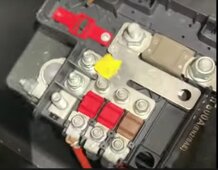Hoping someone can help here, perhaps having had the same issue with the same or similar vehicle.
We installed a Victron 12v 30A DC-DC non-isolated charger into a motorhome built on a 2022 Peugeot Boxer with smart alternator.
We’ve installed many DC-DC chargers, quite a few on vehicles with smart alternators. In some cases we have had to tweak things but always got it working.
In this particular case the DC-DC charger seems to not like the base vehicle at all.
Before we give up on this particular base vehicle and charger combination just checking to see if someone faced this issue and found a solution.
The Problem - Low Input Voltage causes lock-out
After starting the vehicle the input voltage builds up in the usual way and the charger kicks in with around 30A (usually max 13v).
After a short time of running the charger detects a low input voltage, sometimes right down to 7v.
Then the input voltage lock-out kicks in and the charger stops charging (as expected).
The input voltage comes back up and the process is repeated again and again.
The charger is working at around half the time.
The Setup
Victron 12v-12v 30A DC-DC non-isolated charger
460AH 12v LiFePO4 battery
16mm² (5awg) cables used throughout
Pos 1.2m (4ft) from starter battery pos terminal to the DC-DC.
Pos 0.6m (2ft) from DC-DC to the LiFePO4 battery.
Neg 1m (3ft) from DC-DC to the chassis (good solid connection) and LiFePO4 battery
D+ cable connected to the green terminal block on DC-DC (Right “H” connector)
We’ve tried
With and without using “Engine shutdown detection” (don’t really need it because we have D+).
When using Engine shutdown detection we’ve tried default (smart alternator) plus a whole bunch of variations
Lowered the input voltage lockout right down to 12v with 12.5v reset
Different 30A charger (same model) just in case of fault (same result)
Lower amp 18A Victron DC-DC charger (same result)
Different cables (same result)
We installed a Victron 12v 30A DC-DC non-isolated charger into a motorhome built on a 2022 Peugeot Boxer with smart alternator.
We’ve installed many DC-DC chargers, quite a few on vehicles with smart alternators. In some cases we have had to tweak things but always got it working.
In this particular case the DC-DC charger seems to not like the base vehicle at all.
Before we give up on this particular base vehicle and charger combination just checking to see if someone faced this issue and found a solution.
The Problem - Low Input Voltage causes lock-out
After starting the vehicle the input voltage builds up in the usual way and the charger kicks in with around 30A (usually max 13v).
After a short time of running the charger detects a low input voltage, sometimes right down to 7v.
Then the input voltage lock-out kicks in and the charger stops charging (as expected).
The input voltage comes back up and the process is repeated again and again.
The charger is working at around half the time.
The Setup
Victron 12v-12v 30A DC-DC non-isolated charger
460AH 12v LiFePO4 battery
16mm² (5awg) cables used throughout
Pos 1.2m (4ft) from starter battery pos terminal to the DC-DC.
Pos 0.6m (2ft) from DC-DC to the LiFePO4 battery.
Neg 1m (3ft) from DC-DC to the chassis (good solid connection) and LiFePO4 battery
D+ cable connected to the green terminal block on DC-DC (Right “H” connector)
We’ve tried
With and without using “Engine shutdown detection” (don’t really need it because we have D+).
When using Engine shutdown detection we’ve tried default (smart alternator) plus a whole bunch of variations
Lowered the input voltage lockout right down to 12v with 12.5v reset
Different 30A charger (same model) just in case of fault (same result)
Lower amp 18A Victron DC-DC charger (same result)
Different cables (same result)



